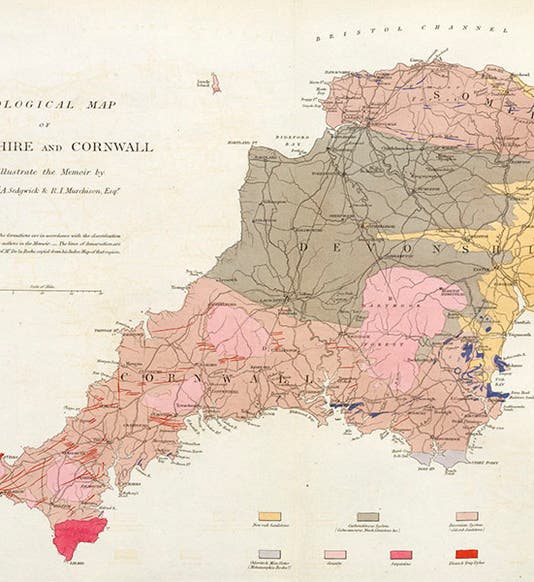Scientist of the Day - William Lonsdale
William Lonsdale, an English geologist and paleontologist, was born Sep. 9, 1794. Lonsdale is often considered the father of the Devonian system of rocks, even though he did not name it. In 1839, Roderick Murchison and Adam Sedgwick published a paper in the Philosophical Magazine in which they maintained that the rocks of south Devonshire are younger than the Silurian rocks that had just been discovered by Murchison, and older than the Coal Measures (or Carboniferous rocks, as we would call them) that lay to the northeast. In their paper, Murchison and Sedgwick named this intermediary collection of formations the Devonian system. And they gave full credit to Lonsdale for being the first to point out the intermediate age of the Devonshire formations (second image).
There is some doubt that Lonsdale ever actually said as much, but he was happy to accept the credit, and he published a paper in 1840 in which he offered his own evidence for the age of the Devonian (third image). This evidence was drawn mostly from fossil corals, a subject on which he was indeed the world's foremost expert. He included a plate showing Devonian corals with his paper (fourth image). The same volume just happens to contain another paper on the Devonian system by Murchison and Sedgwick, accompanied by a map of southwest England, with which we lead off (first image).
Lonsdale occupies another small niche on the history of science wall of fame, this one relating to Charles Darwin. In 1844, Darwin had written a long manuscript "Essay" describing evolution by natural selection. He did not want to publish it yet, in such rough form, but should he die (as then seemed possible, as he had been quite ill), he wanted to make sure that it was published. So he wrote a letter to his wife Emma, listing the editors he would prefer to present his work to the public. His first choice (out of a list of 7) was the geologist Charles Lyell, his second was the invertebrate zoologist Edward Forbes, and his third choice was Lonsdale, which means Lonsdale came in ahead of Darwin's good friends Joseph Hooker and Hugh Strickland. Clearly Darwin respected the man who knew all about corals. Perhaps this admiration inspired Darwin's next career move, which was to become the man who knew everything about barnacles.
There are many portraits of William Lonsdale that pop up on an image search, but all of them show an Australian colonial administrator of that name, and none of them depict our coral expert. A search of the National Portrait Gallery was likewise unsuccessful. Lonsdale is one of the very few members of the larger Darwinian circle who cannot be visually identified.
Dr. William B. Ashworth, Jr., Consultant for the History of Science, Linda Hall Library and Associate Professor, Department of History, University of Missouri-Kansas City. Comments or corrections are welcome; please direct to ashworthw@umkc.edu.









